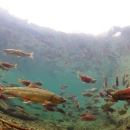Bull trout (Salvelinus confluentus) are listed as threatened under the Endangered Species Act (ESA) throughout their range. This synthesis was developed to answer the following three questions regarding their use of the mainstem Columbia and Snake rivers:
1) Do bull trout from subbasin tributary populations migrate to mainstem areas of the Columbia or Snake rivers, and if so, when?
2) If migratory bull trout enter the mainstem Columbia or Snake rivers, what is the temporal and spatial extent of their migrations?
3) Do Federal Columbia River Power System (FCRPS) dams and reservoirs and their associated operation affect bull trout in the mainstem Columbia and Snake rivers?
This report reviews, analyzes, and synthesizes empirical data and anecdotal information on bull trout use of the mainstem Columbia and lower Snake rivers (hereafter referred to as the “mainstem”). This information and these findings may be useful for informing, in part, ESA Section 7 Section 7
Section 7 Consultation
The Endangered Species Act (ESA) directs all Federal agencies to work to conserve endangered and threatened species and to use their authorities to further the purposes of the Act. Section 7 of the Act, called "Interagency Cooperation," is the mechanism by which Federal agencies ensure the actions they take, including those they fund or authorize, do not jeopardize the existence of any listed species.
Learn more about Section 7 consultations that involve bull trout as well as recovery planning under Section 4 of the ESA for this threatened species. Within the mainstem, we describe the potential impacts of hydroprojects, their configuration and operations, and associated impoundments on bull trout that use the mainstem. For this assessment, we first discuss what is currently known about bull trout movements, migrations, and mainstem use by tributary subbasin. Bull trout interactions with nine mainstem dams and associated impoundments that are operated under the FCRPS are also described. To synthesize mainstem use as completely as possible and to help inform inferences about potential interactions between bull trout and the mainstem dams and impoundments, and the effects of the dams and impoundments on bull trout life history and connectivity, data and analyses for bull trout interactions with non-FCRPS mainstem projects (e.g., mid-Columbia River) were also considered in this report. In addition to summarizing existing data, we identify critical information gaps that potentially limit the ability to manage and recover bull trout. We also provide recommendations for future research, monitoring, and evaluation that could be useful for tracking the status of connectivity, as well as implementation of actions for restoring connectivity where needed within the assessment area.







